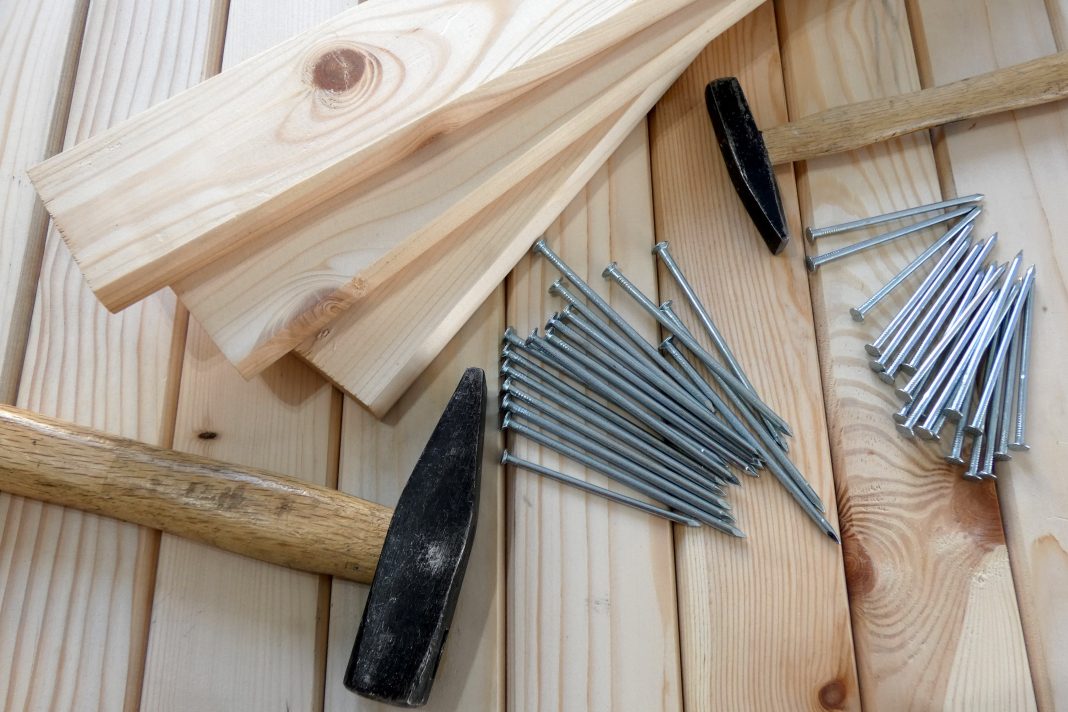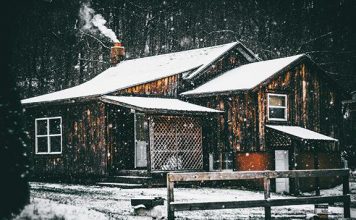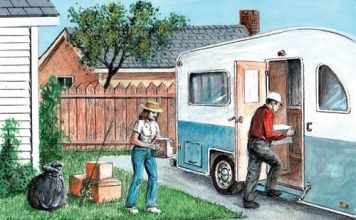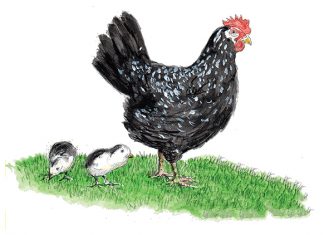| Issue #104 • March/April, 2007 |
A hotbed is a miniature greenhouse that is heated to protect new seedlings from cold. The hotbed differs from a cold frame in that it has an internal source of heat while the cold frame is heated only by the sun. It may be heated with artificial heat by placing greenhouse-type soil heating coils below the soil in which the plants will grow, but this article will address the construction and use of a traditional system using heat from the decay of animal manure.
Selection of materials
My preferred way to obtain materials for construction is by salvaging useful things from demolition or remodeling projects or by purchasing things at a very low price at farm auctions. I am always on the lookout for items that I may someday use (much to my wife’s dismay) and I store it out on the “back 40.” I got a lot of glass from the demolition of a large warehouse that I someday hope to use to build a greenhouse. I also got some large metal window frames that have small panes of translucent glass and much of the glass panes were intact. For the hotbed, I selected one of the frames that had only one or two panes broken out, took some glass from one of the other frames, and replaced the broken panes. This window frame then became the basis for my hotbed construction project. The dimensions of the window frame determine the size of the hotbed.
|
Other items that would serve for hotbed glass could be old storm doors or one section of a discarded sliding glass door. If your wife has been after you for years to get rid of the old sliding glass door that goes out to the patio, now is the time to make her happy with the new door, and you get the glass you need for the hotbed at no additional charge. In general, just keep an eye out for glass that would work for the project, and it will likely cost little or nothing. I have also seen sliding glass doors in the “free” section of www.craigslist.org. That requires just keeping up on the listings so you get there before the other person looking for a hotbed lid.
Following through with the idea of using salvaged materials, I had some pressure-treated 4x4s that had been discarded from someone’s construction project that I used for corner posts and some cedar 2x6s for the frame. I had a can of spray foam that I had picked up somewhere that would fill cracks in the frame. There were some hinges on the shop shelf that have been lying there for years that, with construction screws to hold everything together, completed the building materials list.
The other required components for the hotbed include some fairly fresh manure that is high in fiber, such as horse manure or other manure that includes a high percentage of straw, and some compost and topsoil. If you don’t have the required manure, you almost certainly have a neighbor with a horse that would be only too happy to have you carry off some surplus horse manure. Some good compost or other good planting medium is required to place on top of the fresh manure. I used some very old manure that had set for years as my compost and mixed it with some good sandy loam topsoil that I have on my place.
Construction of the hotbed
Again, using the window frame as a guide, I laid out the size of the hotbed and dug a hole of that size, about three feet deep. Since I wanted to have a permanent hotbed, I set the 4x4s as posts in the four corners. You could also just make a frame that sits on top of the ground and place it over the top of the prepared bed.
|
I measured and cut two cedar 2x6s the length of the window frame and two 2x6s the width of the window. These would form the basis for the hotbed frame.
After setting the posts, I screwed the measured 2x6s to the posts at ground level and measured to make sure I had square corners. I always use the “3, 4, 5” system that my father taught me to square construction corners that are larger than practical for a standard carpenter’s square (I could have used a standard square on a project of this size, but I was too lazy to run back to the shop to find the square, and I had my measuring tape). It was not until I took geometry in high school that I learned that Dad was really using the Pythagorean Theorem (the square of the hypotenuse of a right triangle equals the sum of the squares of the two sides). Using 3, 4 and 5 units of measure, measure three feet (or inches, yards, centimeters or meters, or use multiples such as 30 inches, 40 inches and 50 inches) along one side of the frame, mark it, measure four feet along the other side, mark it, and then measure the distance diagonally between your marks and if it is 5 feet, the corner will be square. If not, adjust the corner until the diagonal measure is 5 feet to square it up.
This mathematical model for establishing a square corner works as follows: If the first side is 3 feet and the second side is 4 feet, the hypotenuse, or diagonal between the sides, is 5 feet because 3 squared (3×3=9) + 4 squared (4×4=16) equals 25. The square root of 25 (or the number multiplied by itself that equals 25) is 5. This provides the basis for the “3, 4, 5” system.
After getting the corners square using this system, I measured diagonally from corner to corner of the frame and then from the other diagonal corners to make sure they were the same as a final check. Holding the sides in place to maintain the square corners, I packed soil around the posts to hold them in place. I measured again to make sure the corners were still square.
I wanted the north side of the hotbed to be about one foot higher than the south side so that it would get more direct light from the sun. I cut the south posts off about 6 inches above the ground surface and the north ones 18 inches above the ground surface. I measured and cut more cedar 2x6s to make sides for the frame of the hotbed.
|
With the posts in place and the frame constructed, I used soil I had dug out of the hole to backfill around the outside of the frame. I built soil up around the back (north side) of the frame within 6 inches of the top so it would provide insulation from the cold.
The basis for the heat source is a thick layer of manure that will decay and give off heat as a by-product of microorganism activity. The heavy concentration of bacteria and fungi organisms in the decaying manure gives off carbon dioxide and heat. The heat rises through the planting medium, heating it and the air inside the hotbed. With the heat from solar radiation through the glass, this keeps temperatures well within the range for good plant germination and growth.
To provide that organic heat source, I placed enough fresh, straw-filled manure in the pit of the hotbed to make a layer about 2½ feet thick. I packed it in and leveled the top before placing 6 inches of planting medium on it. For the planting medium, I mixed well-composted manure and loamy sand soil together to form a mixture that would provide good drainage and good fertility and then placed it in the hotbed on top of the fresh manure.
Before putting the glass frame in place, I used spray-can insulating foam to fill in cracks and gaps between boards in the frame. I placed the glass on top of the wooden hotbed frame and made sure that it fit snugly. I had to shave off some high spots in the cedar frame to fit it well. Then I drilled holes in the metal window frame and attached the hinges, fastening them to the cedar with construction screws. I cut two 2x4s two feet long to use for props to hold the glass up while working in the hotbed or to provide ventilation.
Using the hotbed
The hotbed should not be filled with manure and planting medium until late winter so the manure will begin to heat in time to grow spring plants that will be used to set out in the garden after danger of frost is past. Water must be added to the hotbed to keep the manure moist, providing a good environment for the growth of microorganisms that provide heat. About six weeks (depending upon the type of plants) before the normal date for the last frost of the season, prepare the seedbed in the planting medium and plant the seeds. Since the plants will be lifted from the hotbed and put out in the garden at proper growth spacing, the seeds and rows can be much more dense than normal seed spacing.
|
Because the hotbed generates high levels of heat from the sun, I place a light cover of straw mulch over the planted seeds. This provides a bit of shade for the soil during the day when the sun is shining and helps hold in a slight amount of heat at night. The most important function, however, is slowing the rate of evaporation in the surface of the planting medium. I have found that without the straw, the surface dries out so quickly that many of the seeds have difficulty germinating. The straw mulch should be sparse enough that light will get to the seedlings as they emerge from the soil.
On sunny, mild days, it will be necessary to ventilate the hotbed to prevent it from becoming so hot that it dries out the soil and germinating seeds or burns the young plants after they emerge. I used the 2×4 props cut at the time of construction to hold the window frame up and provide the necessary ventilation. It must remain closed on cold days and at night to keep the heat from escaping and to keep the plants from freezing.
In the high plains of Colorado where I live, we can have a series of warm days and then have a blizzard or below zero temperatures. When we have very cold nights, I cover the hotbed with an old blanket and, if snow is predicted, I add a small tarp to keep the blanket dry. This added insulation prevents the cold from damaging the seedlings. Double-pane windows would also aid in keeping the heat in at night, but I used what I had available.
With just this small hotbed I was able to grow enough plants for our large garden. I grew not only tomatoes and peppers but also cabbage, cauliflower, broccoli, lettuce, and some herbs that allowed me to get a head start on quite a few cold-tolerant plants as well as the warm season plants.


















